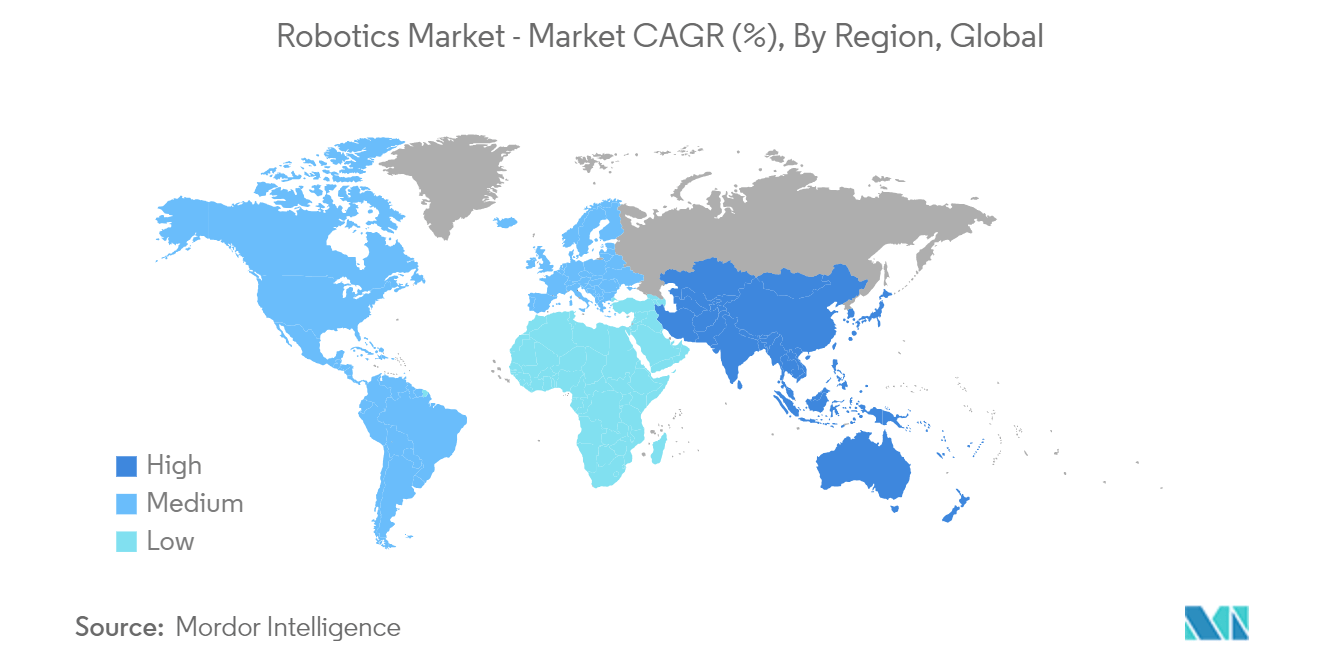Market Trends of Robotics Industry
Service Robots to Lead the Market During the Forecast Period
- Professional robots are primarily utilized outside manufacturing facilities in various professional settings. While industrial robots focus on automating manufacturing tasks, professional service robots—diverse in both form and function—take on menial, dangerous, time-consuming, or repetitive tasks. This automation allows human workers to engage in more cognitive functions.
- When businesses deploy professional service robots, safety is paramount. Instead of replacing human workers, these robots manage hazardous tasks, enabling humans to concentrate on cognitive functions and stay safe. For instance, in the defense sector, professional service robots are designed to shield soldiers from harm during combat.
- Advancements in technology have largely enhanced the functionality of security robots. These robots can be deployed in challenging scenarios for surveillance, with actions determined by sophisticated analytics. By integrating various sensors, professional robots have become adept at environmental analysis, yielding more dependable data. This evolution has notably bolstered their roles in security and patrolling.
- In addition, field robots are gaining traction in agriculture and construction. These robots are engineered to undertake tasks that are often challenging, hazardous, and time-intensive for humans, including bricklaying, demolition, and crop planting.
- Field robots, equipped with sensors like cameras, lidar, and GPS, autonomously navigate and perceive their surroundings. These advantages have spurred numerous manufacturers to develop field robots.
- The demand for domestic robots, particularly assistance, companion, and entertainment robots, has surged. This uptick is largely attributed to an aging population and a growing number of individuals facing mobility challenges.
- The World Health Organization (WHO) highlights a global trend: people are living longer, with many expecting to reach their sixties and beyond. This trend is universal, with every nation witnessing an increase in the number and proportion of older individuals. Projections indicate that by 2030, one in six people worldwide will be aged 60 or even older, with this demographic swelling from 1 billion in 2020 to 1.4 billion. By 2050, this number is set to double to 2.1 billion, and those aged 80 and above are expected to triple, reaching 426 million.
- According to the IFR, robots for domestic tasks constituted the largest group of consumer robots. Vacuuming and other indoor domestic floor cleaning robots are currently the most used applications. In 2023, the shipments of robots for domestic tasks and entertainment robots were anticipated to reach 48.6 million and 6.7 million, respectively. Such developments are expected to drive the market's growth in the future.

Asia Pacific Expected to Witness Significant Growth
- China is leading the global manufacturing industry and creating significant market demand. More Chinese manufacturers are adopting Industry 4.0 solutions to improve efficiency, driving further market growth.
- China's manufacturing sector is quickly moving toward Industry 4.0, with the country being a key player in the digital revolution. China focuses on innovation and boosting competitiveness by leveraging its strong industrial base and technological knowledge. Under initiatives like "Made in China 2025," the Chinese government aims to bolster the nation's manufacturing prowess and foster high-tech industries. Such initiatives are likely to drive the growth of the market.
- In addition, South Korea, bolstered by a robust manufacturing sector and steadfast government support for tech innovation, stands at the forefront of adopting industrial automation. With its technological strides and industrial might, the country is poised to excel and significantly bolster its economic standing in this market.
- South Korea's thriving automotive sector presents promising prospects for expanding the market studied. South Korean car manufacturers, including Kia and Hyundai, are ramping up production capacities and significantly investing in R&D, buoyed by rising global interest in electric vehicles and government support for bolstering domestic manufacturing.
- The automotive industry in Taiwan has experienced significant growth in recent years. With a focus on electric vehicles and smart mobility solutions, Taiwan positioned itself as a key player in the global automotive industry. In addition, Taiwan's expertise in semiconductor manufacturing allowed it to supply critical components for advanced driver-assistance systems (ADAS) and autonomous vehicles.
- In addition, Japan's automotive sector, which historically contributes to over 89% of the nation's GDP, is undergoing a significant shift. Driven by Japan's ambitious targets of achieving net-zero emissions by 2050 and a 46% reduction by 2030, electric vehicles (EVs) are gaining traction.
- Further emphasizing this shift, Japan's Ministry of Economy, Trade, and Industry (METI) set an even more ambitious goal under the Green Growth Strategy: achieving a 100% sales share for EVs by 2035. Notably, hybrid electric vehicles (HEVs) are already a significant player, accounting for nearly 30% of total vehicle sales in Japan.


